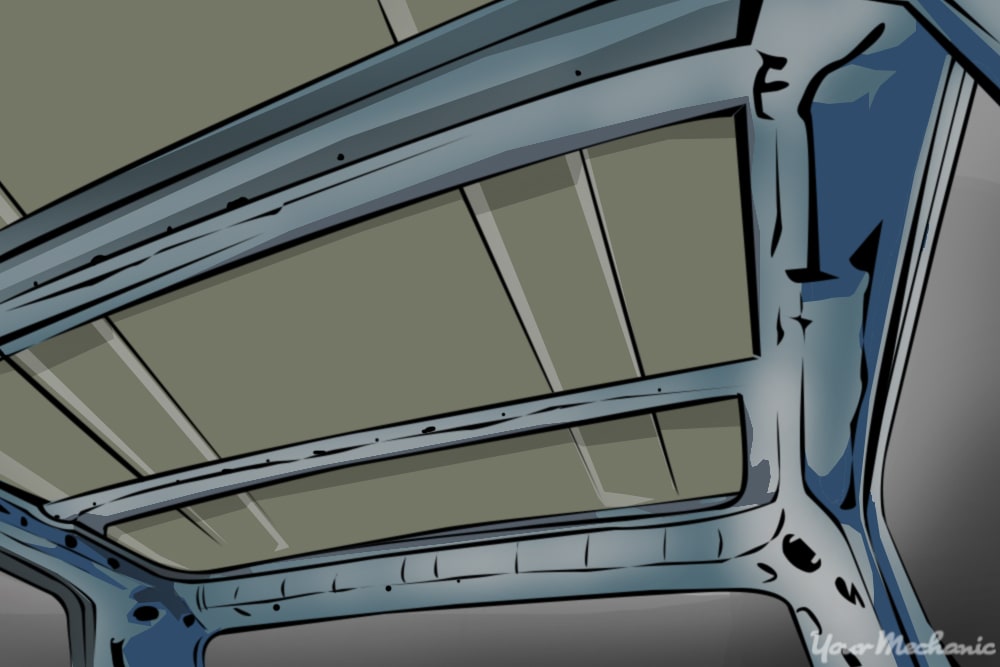
Sand the entire 1940 Ford roof to remove any buildup of glue left by the old headliner. Doing the job yourselfHeres some good 3M headliner adhesive.

You can adjust the listing.
How to install a headliner in a car. Pry off all the trim that surrounds the headliner and holds it in place. Detach and remove all of the seatbelt covers lights speakers visors and clothes hangers. You may also have to remove.
Unclip any clips that are holding the headliner board in place. Slide the headliner board out of the. Installing a new headliner in a classic car can seem a little intimidating to most car guys who are more comfortable with a wrench in their hand and grease beneath their nails.
The process is actually relatively easy and with a little time and patience most car enthusiasts can achieve professional quality results at a fraction of the price. This video will show you how to remove the old headliner mark the position of the rods used to hold up the headliner remove the metal brackets used to hold. Use scissors to trim the sleeve to just below where the rod makes the bend.
Once you get the rods back in the new headliner you are ready to hang it in the car. The new headliner may have some wrinkling due to packaging and shipping but not to worry when you pull it tight while installing it in the car. The wrinkles will start to dissapear.
This video will show you how to stretch the headline from front to back and side to side. It also shows how to trim off the excess headliner and add the p. In this upholstery training video I will show you how to easily install a suspended headliner.
All you need is a staple gun steamer scissors spring clamps. Doing the job yourselfHeres some good 3M headliner adhesive. Httpsamznto2wsxYr0A big thanks to Headliners O.
Gene sets the new panels on the headliner material carefully so it lies out smoothly and then folds the top and bottom edges over trimming the material to leave about a 34-inch wrap. The ends however are not folded over and are left loose for now. These will tuck into the cars tack strips.
Lift the headliner to the roof and install the number 3 wire rod. Work toward the rear and install the side to side wires. Then if present snap the listing wire or wires into longitudinal bow receptacles.
Then work forward and install remaining side to side wires. You can adjust the listing. Pull the quarters diagonally into the corners of the car and fasten in place.
Finish the rear quarters and trim off excess materials. Push the headliner into the rear window ring and fasten at the center top and bottom then work your way around the ring. You may have to cut a relief in the center of the fabric.
This is a video to show you how to install a custom headliner. This was the first headliner Ive ever done so it may not be perfect. This was a very cheap an.
Cut it to the exact measurements of the 14 luan in the second step. Round the rear corners with a large coffee can and the front corners with a spray paint can. Mark a center line on the front and back sides of it.
Next up youll need to decide how far in you want the stitch line to be on the final headliner. Sand the entire 1940 Ford roof to remove any buildup of glue left by the old headliner. Cover one side of the new Ford headliner in a coat of glue.
Apply this one side of the Ford headliner to the sanded roof of the Ford. Apply pressure to the non-glued side until the headliner sticks. Look for any overlapping material on the new Ford headliner.
As for professional installation its best to double this rate meaning a four-door sedan will cost about 200 for a new headliner professionally installed or about 500 for a professional to install a new headliner in a larger vehicle or specialty car. This would include the materials and professional rate. Before we start stapling the headliner in we need to set the position and pull tension on the headliner from front to back.
Use the spring clamps to help keep the material tight while we are working out wrinkles. Slowly and gently pull the material tight using the spring clamps to keep it in place. As seen in the accompanying photos the headliner on the project GTO was installed in a car with no interior including the dashboard and none of the glass.
That definitely made the job easier as it provided more room to maneuver but the project can certainly be accomplished with the window glass in place.